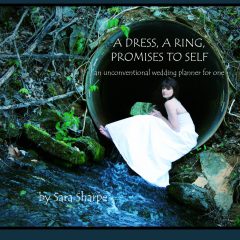 As a big proponent of building self-love, I was fascinated by Sara Sharpe, who married herself. At first I thought it was weird but now I understand it was a pledge to love and honor herself. She explains it in details in her book, A Dress, A Ring, Promises to Self: an unconventional wedding planner for one.
As a big proponent of building self-love, I was fascinated by Sara Sharpe, who married herself. At first I thought it was weird but now I understand it was a pledge to love and honor herself. She explains it in details in her book, A Dress, A Ring, Promises to Self: an unconventional wedding planner for one.
A Dress, A Ring, Promises to Self
by Sara Sharpe
I’ve been closely following the story of Fargo, ND local Nadine Schweigert, who “married herself” in a commitment ceremony last March. Last week, Schweigert appeared on Anderson Cooper’s day time talk show to talk about her ceremony. During the introduction, Anderson bluntly asked, “Is it empowering or is it creepy?”
Presenting the question in such a way is, one supposes, good for ratings. These days, it would seem, a story is hardly news worthy without some inherent controversy. Brad Wilcox, for instance, Director of the National Marriage Project, accuses Nadine of being “a bit confused.” His concern, apparently, is that marriage is not a “solo act.” Marriage, according to Wilcox (who also appeared on Anderson’s show), is about “bringing two different people together.”
Well, yes. But as someone who performed a similar commitment ceremony in 2001, I can assure Mr. Wilcox that those of us who “marry ourselves” are not confusing an important symbolic gesture with the institution of marriage. (Did I really just have to write that?)
No one – not even Mr. Wilcox, I daresay – would quibble with the idea that committing to a program of self-care makes good sense. What some of us recognize, however, is that while making a commitment is one thing, following through can be quite another; because lifelong habits (of co-dependency, for instance) are hard to break. But by specifying and ritualizing the commitment and, better yet, by wearing a ring that serves as a constant reminder, the promises one makes to oneself seep into the cells, as it were, and become a part of one’s permanent makeup – the framework around which to build a life. For those of us who have spent years in relationships in which we performed daily acts of self crucifixion as a matter of course, the value of this particular symbolic gesture cannot be overstated.
It’s a good thing, as it turns out, that Nadine is committed to taking good care of herself in good times and in bad, as she’s been the recipient of some relentlessly snarky commentary – all of which she’s handled with uncommon grace. Now, don’t get me wrong. I recognize that the idea of “marrying oneself” is ripe for parody. (I am an actor, after all.) In fact, my friend Trevis, inspired by the little book I wrote about my own ceremony, has written extensively about grounds for divorcing oneself. “Your honor,” he writes, “I find that I’m spending less and less time with myself, and that I have less in common with myself than before. And, frankly, if I am forced to continue to listen to myself snore, I may just up and leave myself without notice. In fact, I seek an injunction against myself though, legally, I’m not sure what I mean…”
Let the hilarity ensue. I totally get it. But let’s not forget that shoddy self care and damaging relationships are common enough that in addition to our laughter, we might entertain the idea Nadine is on to something here. Because, really, there’s nothing creepy or confused about recognizing the value in making a commitment to love, honor and care for oneself so that one might better love, honor and care for others.
Take that, Anderson.
****
Sara Sharpe is the author of A Dress, A Ring, Promises to Self: an unconventional wedding planner for one. Check it out and see why marrying yourself can be a great act of commitment to self-love.
***************
Take the 31 Days of Self-Love Challenge–a pledge to do something loving for yourself for the next 31 days–and get my book, How Do I Love Me? Let Me Count the Ways for free at http://howdoiloveme.com. Read my 31 Days of Self-Love Posts from 2012 HERE.
Please leave comments under my posts so we can stay connected.

